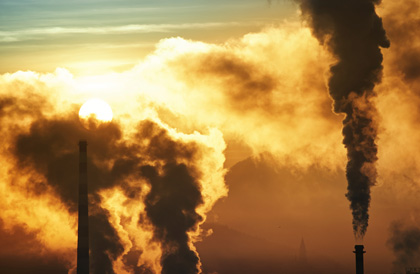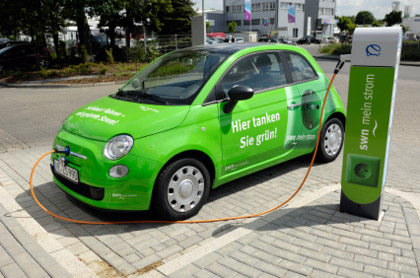Running Out of Time: Climate Change Policy Failures
In January 2011, the National Aeronautics and Space Administration (NASA) and National Oceanographic and Atmospheric Administration (NOAA) jointly announced that 2010 tied 2005 as the hottest years in recorded human history, and all of the 10 hottest years on record have come after 1998. Despite more than two decades of scientific research on global warming and countless dire warnings, the United States has continued to discharge more heat-trapping greenhouse gases (GHGs) exacerbating climate change risks. The U.S. government and most business enterprises have done virtually nothing to stabilize or to decrease GHG concentrations in the atmosphere while precautionary efforts of concerned politicians and regulators have almost always been unrealistic and self-defeating. The central theme of this essay is that, to an overwhelmingly degree, American political and economic leaders who recognize the dangers of climate change risks do not have any clear idea about how to design effective climate change mitigation programs. Instead, these leaders have been following a conventional GHG emissions-reduction approach bound to fail in the present and future.
Climate change is not a single definable threat to American national interests; rather, it is a combination of hundreds of complex ecological and economic impacts, many with overlapping effects. Any compendium of diverse climate change risks involves a wide range of internal national security risks and international risks that may directly or indirectly harm the U.S. It is doubtful that any category of human welfare risk will be as perilous as global climate change in the 21st Century, except possibly nuclear proliferation. However, nuclear warfare threats are unlikely to materialize no matter how horrible the devastation may be while global warming and related climate change dangers are growing closer and closer to certainty.
Everyone with a serious interest in this subject is already well aware of the worldwide range of climate change hazards, such as sea level rise, floods, droughts, wildfires, higher surface temperatures, decreasing potable water supplies, degradation of wetlands and coral reefs, acidification of ocean waters, expansion of tropical diseases, widespread ecosystem degradation with innumerable species extinctions, agricultural crop losses from higher temperatures and unpredictable weather conditions and increases in extreme weather events, to name only a limited number of familiar climate change hazards among an expanding array of disasters.
As one example, 2012 is the first year four tropical storms reached sufficient strength to warrant the imposition of National Hurricane Center designated names before the 4th of July, which until recently was considered the beginning of the hurricane season. One of these storms, slow-moving Tropical Storm Debbie, settled off the Florida Gulf Coast in late June causing several fatalities and large property losses from flooding and “isolated tornados,” according to MSNBC.com. This June 25th news story also noted that “23 percent of oil and gas production in the region had been suspended” while “employees have been evacuated from 13 drilling rigs and 61 production platforms in the Gulf of Mexico.” Nearly everyone is familiar with the greater number of deaths and fiscal costs of Hurricane Katrina a few years ago, but every extreme weather event may produce unpredictable results with severe losses.

© iStockphoto.com/nielsquist | A digging project for sea-level rise and beach erosion control.
As a second example, a June 2012 NOAA study noted sea levels along the U.S. East Coast have been rising appreciably faster than in other coastal regions. NOAA findings concluded an average sea level increase of 2 inches along the eastern coast since 1990, but a 4.8-inch rise occurred in Norfolk, Va., a 3.7-inch rise in Philadelphia, and a 2.8-inch rise in New York City. These increases have their greatest impacts during storms and high-water conditions. One NOAA official, quoted by MSN.com on June 25th, said the ramifications of these findings are “huge when you think about it. Somewhere between Maryland and Massachusetts, you’ve got some bodaciously expensive property at risk.”
As a third example, the New York Times reported on June 28, 2012, that 41 regional heat records had been broken in the western U.S. during the previous week, mostly in Colorado, Kansas and Nebraska. Concurrently, a wildfire near Colorado Springs burned more than 18,000 acres, and 34 other large fires were still burning in the country. At the end of June, unusually destructive heat waves, wildfires and tornados had wreaked massive damage in the southern Atlantic region, especially Virginia and the District of Columbia. A group of prominent scientists agreed in a joint statement that those weeks’ events fit into a pattern of extreme weather events and catastrophic fires, which climate scientists predict will only worsen in decades to come.
This essay could be filled to the brim with additional examples of national and international climate change risks leading to ecological degradation and human welfare disasters; but it is much more important to discuss the following:
- Why have American mitigation efforts been consistently heading in the wrong direction, and
- How can we make substantial progress in controlling these dangers?
It is widely known that some U.S. politicians and business leaders refuse to acknowledge climate change as a serious problem because they have close dealings with fossil fuel companies and with states benefitting from employment in those industries. However, the main topic here is the consistent failures of American climate policymakers who do want to control climate change hazards and, yet, who seem wholly unable to do so. Unfortunately, sincere but not sufficiently informed or committed climate policymakers may in practice be more harmful than short-sighted lobbyist sponsors of “denial.”
Stocks & Flows of Cumulative GHGs
Various scientific complexities hamper efforts to understand global warming and climate change processes, including effects of clouds, winds, ocean currents, surface reflectivity (albedo) and sunspot cycles. Yet, there is no question that the central causal factor is increasing volume of heat-trapping GHGs discharged into the air by polluting activities, which prevent sufficient heat from being reflected back into space or the stratosphere.
The conventional “solution” for this air pollution problem has been establishment of a multi-decade GHG emissions-reduction program with discharge caps gradually becoming more stringent throughout several decades. This is the consensus approach embodied in the Waxman-Markey Bill, which was approved by a close partisan vote in the House of Representatives but later rejected after the 2010 election changed House membership. The same emissions-reduction approach was incorporated in the Kerry-Lieberman Bill that commanded a majority of the Senate but was unable to overcome the threat of a Republican filibuster. This multi-decade emissions-reduction program, with the large majority of GHG reductions deferred until the last period of the plan, was also at the core of the Obama Administration proposals, second commitment period of the Kyoto Protocol, European Union Emissions Trading Scheme, Regional Greenhouse Gas Initiative in 10 eastern states, California Cap-and-Trade program and Clean Car program, and every other major climate change mitigation program that has come close to legal adoption or implementation.
Below are mandated GHG emissions-reduction targets up to 2050 specified in the Waxman-Markey (Obama proposals nearly identical) and Kerry-Lieberman Bills:
| Waxman-Markey Bill | 2012 | 2020 | 2025 | 2030 | 2050 & after |
|---|---|---|---|---|---|
| Cuts below 2005 levels | 3% | 20% | 30% | 42% | 83% |
| Residual GHG Discharges | ~6 billion tons (6 GTs)/yr |
~4.8 GTs/yr | ~4.2 GTs/yr | ~3.6 GTs/yr | ~1.2 GTs/yr |
| Kerry-Lieberman Bill | 2012 | 2020 | 2025 | 2030 | 2050 & after |
| Cuts below 2005 GHGs | 4.75% | 17% | same | 42% | 83% |
| Residual GHG Discharges | ~5.7 GTs/ yr | ~5 GTs/yr | ~5 GTs/yr | ~3.6 GTs/yr | ~1.2 GTs/yr |
The rationale for this approach is that spreading the emissions-reduction burden throughout several decades would decrease applicable pollution control costs and encourage innovation by major GHG dischargers and other entrepreneurs. More rarely mentioned are the advantages for present politicians, who will not be deemed responsible for the ambitious, difficult, expensive emissions-reduction measures deferred to later decades and deliberately imposed on future leaders and future generations of citizens. Current policymakers can take credit for supposedly addressing climate change problems without actually making any significant alterations in the way American society now operates or in the costs of national and industrial pollution controls for greenhouse gases.
Regrettably, these multi-decade emissions-reduction proposals do not take into account “stocks and flows” properties of the greenhouse gas concentration in the atmosphere. In simple terms, GHG pollution allowed under long-term emissions-reduction programs – called “residual discharges” in the tables above – will combine with the already too high concentration or “stock” of GHGs in the atmosphere to produce an even higher cumulative level (“stock”) of GHGs, thus causing greater climate change dangers. For example, by 2050 the Waxman-Markey and Kerry-Lieberman Bills would allow more than 150 billion tons of residual GHG discharges to combine with and increase current GHG concentration in the air, which is already producing an expanding range of climate change dangers.
A fundamental flaw in conventional mitigation programs is the focus on how much emissions can be reduced each year without considering aggregate impacts of remaining (residual) GHG pollution, which would be allowable discharges under emissions-reduction plans. For example, eliminating 50 percent of annual GHG discharges would allow the other 50 percent to continue expanding the cumulative concentration of GHGs in the atmosphere. Thus, combining annual “flows” of new GHG pollution with the GHG “stock” already in the atmosphere would increase cumulative GHG concentration and its resultant climate change risks even if each year’s GHG discharge level is significantly curtailed. It is the aggregate stock (concentration) of GHGs in the air, not the annual flows of new GHGs, which will determine whether global warming and climate change will continue to get worse.

© iStockphoto.com/ermingut
|Greenhouse gases from industrial pollution.
Climate Change Policy Failures: Why Conventional Mitigation Approaches Cannot Succeed, a book written by this essay’s author and published in May 2012, describes the weaknesses of conventional multi-decade emissions-reduction programs and the relevance of a “stocks and flows” analysis in far greater detail. For example, the most common greenhouse gas, carbon dioxide (CO2), is highly persistent. Recent scientific studies have found that CO2 discharges are likely to remain in the atmosphere for centuries or millenia. As a result of this persistence, delaying the time frame for substantial GHG emissions reductions by decades and allowing billions of tons of residual GHGs to increase the aggregate concentration in the air every year has been a disastrous climate-policy decision. This deferred mitigation approach may be convenient for present-day politicians and businesses, but it is creating a Sword of Damocles that will hang over the heads of billions of vulnerable people for centuries to come.
Climate Change Policy Failures also contains a chapter describing the conflicts in national interests and policies between developed and developing nations. Nearly universal agreement concludes that the United States and other relatively affluent, developed states will not be able to resolve global climate change problems without cooperation of large GHG-polluting developing nations, especially China and India, which now rank among the worst GHG dischargers. However, these developing countries are adamant about not accepting multi-decade emissions-reduction obligations that create serious barriers to economic growth and poverty alleviation. Developing nations also want financial aid from affluent states for mitigation and adaptation activities without “strings,” which they feel would reintroduce colonialism and imperialism in practice. However, developed nations are not going to provide up to $100 billion per year in financial assistance for climate change programs without being reasonably certain they will receive what they are paying for. The result of these conflicting positions has been an international climate-policy stalemate.
It is crucial to recognize that the conventional multi-decade emissions-reduction approach is not giving developing states what they want. Many poor nations believe this approach is actually an intentional way to restrain their future growth while others believe it will create competitive disadvantages during a time when economic growth seems more important than climate change mitigation. Climate Change Policy Failures argues that stakeholders can only achieve a genuine international agreement by meeting the primary goals of both the North and South blocs: An effective climate policy must decrease global climate change dangers while increasing economic and social welfare for developing countries. However, multi-decade emissions-reduction programs do not promote further economic development for poor countries, and, consequently, they have been unable to attain cooperation of those states despite their rapidly growing volumes of GHG discharges.
Alternative Mitigation Strategy
Solving a wide range of difficult climate change and collective-action problems will require shifting the great majority of U.S. regulatory efforts and mitigation investments from a GHG emissions-reduction strategy to a GHG-free, clean technology-replacement strategy. If America continues to rely on ineffectual GHG emissions-reduction programs, the essential program funding, administrative personnel, public attention and precious time wasted on climate-policy failures are sure to preclude more effective precautionary approaches.

© iStockphoto.com/acilo
|A solar-powered, clean, technology-replacement strategy.
The best way, and probably the only way, to reduce GHG discharges enough is to eliminate primary sources of GHG pollution by replacing them with clean GHG-free technologies, processes and practices. Because many GHGs are persistent in the atmosphere, every country needs to begin efforts to replace “dirty” GHG sources with “clean” alternative methods to the greatest extent feasible as soon as possible.
Another advantage of the clean, alternative technology approach is its ability to give developing nations what they want – a better means to improve economies and to increase prosperity – without following “dirty” historical development patterns that exacerbate aggregate GHG concentration in the atmosphere. Adoption of GHG-free, clean alternative technologies can achieve real climate mitigation progress while also achieving better economic and social welfare in developing and developed nations. In contrast, conventional multi-decade GHG emissions-reduction programs cannot achieve either preeminent goal.
No magic wand or incantation exists to overcome global climate change; and no single regulatory initiative or institutional regime could address all complex dimensions of a technology-replacement strategy for combating global climate change. However, Climate Change Policy Failures proposes four overlapping institutions that could help contribute to effective mitigation policy:
- A clean-technology commission composed mainly of members of the National Academy of Sciences and National Academy of Engineers would be responsible for comparatively assessing prospective energy technologies and other methods for replacing major GHG sources. This commission would also be primarily responsible for allocating research funds and subsidies, which could enable preferred alternative technologies to succeed in applicable markets.
- A carbon tax should be implemented to raise the funding necessary for the work of the clean-technology commission as well as to impose a deterrent to help discourage climate-damaging actions.
- A direct regulation program would ensure a rapid decrease in GHG discharges among the handful of most harmful GHG-polluting industries. Market mechanisms alone are probably not capable of overcoming fossil fuel producers and GHG-polluting power plants with trillion-dollar wealth and widespread political influence.
- A mandatory public disclosure program should be instituted for all significant GHG sources, which will create another deterrent initiative encouraging GHG producers and users to look for safer alternatives.
Any effective mitigation program will cost many billions of dollars throughout the next several decades. But climate change disasters are currently costing the U.S. and other nations significantly more now. And, harmful events are bound to become more catastrophic and expensive every year the world’s citizenry allows climate change to keep expanding without meaningful restraints. No inexpensive choice exists between replacing as many greenhouse gas discharges as feasible and suffering increasing impacts of disparate climate change dangers.
Specific examples of climate change harms to American well-being cited above – early tropical storms, disproportionate sea level rises, record western and southern heat waves and wildfires – all occurred in June 2012. These impacts for one month alone caused billions of dollars in property damage as well as a significant number of deaths and injuries. The U.S. political system needs to recognize that climate change risks will become worse next month, the month after and in succeeding years, decades and centuries. If America does not begin to confront these expanding climate change perils in the near future, instead of deferring substantial mitigation for several decades, it will be creating the certainty, not just the possibility, of tragic and very costly consequences for millions of its citizens and for a vast number of vulnerable people in other countries.
American politicians, business people and military planners must recognize that harm to the U.S. from climate change hazards will not be limited to damages directly inflicted on this nation. Rather, millions of newly-destitute people from other countries may try to enter America as a shelter of last resort. Many people suffering from water and food shortages will blame the U.S. as the largest GHG polluter of the past century. In addition, appreciable numbers of people who can no longer tolerate the hostile living conditions created by climate change may take part in rebellions, terrorism and other desperate actions because they see no viable alternatives. U.S. national security will be at risk because the entire world population will be at increased risk from continuing expansion of climate change dangers. It is time to recognize that America and all other nations are running out of time. Continued abdication of political will and moral responsibility to address growing climate change problems is bound to cost Earth’s inhabitants dearly.





























